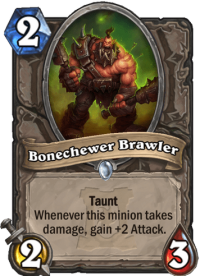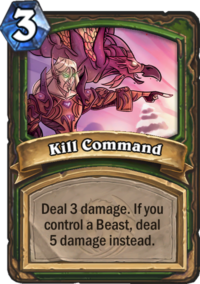Our Highlander Hunter deck list guide for the Madness at the Darkmoon Faire expansion features one of the top lists for this archetype. This Hunter guide includes Mulligan Strategy, Gameplay Tips, Card Substitutions, and Combos/Synergies!
Introduction
Highlander Hunter, as the name suggests, is a deck built around the singleton restriction to enable Zephrys the Great and Dinotamer Brann, leading to game-ending spikes of damage in critical turns to secure the victory. The archetype has found a lot of success in previous metagames as well, but it got progressively faster over time, and it is at its leanest and meanest yet with its early Madness at the Darkmoon Faire builds featuring only a few cards that cost more than 3 mana to play.
Highlander Hunter Deck List
We’ve featured the list from the latest Vicious Syndicate Meta Report because of our successes with it in high level play. Note that many top players reached high Legend with slightly different variations: you can find out more about them in the Card Replacements section below!
Find more versions of this deck type on our Highlander Hunter archetype page!
Mulligan Guide and Strategy
Higher Priority (Keep every time)
With a deck as fast as this (and with limited initiative options to retake the board), you need to aggressively look for one of your premium one-drops in the mulligan.
- Dwarven Sharpshooter – The 1 mana 1/3 statline is excellent by itself for aggressive starts, and the fact that the card text guarantees you a good turn 2 play in faster matchups is a big bonus.
- Blazing Battlemage – Again, a premium statline for turn one.
- Intrepid Initiate – You will almost always find a way to trigger its Spellburst effect in time to get the premium stats, which is why this is a keep at all times.
- Demon Companion – You’re hoping for Shima or Reffuh when played on turn one but since Kolek can be so valuable on a wide board, you don’t want to prioritize this as your turn one play over the other premium minions even though it is a keep in your mulligan.
- Phase Stalker – Either as a vanilla tempo play or the way to fish out a Secret early on, there flexibility of this card is a reason why it has been a staple in Hunter decks since its release.
- Imprisoned Felmaw – It’s a stupid amount of stats for the cost and the fact that it auto-attacks on awakening means you don’t even lose as much tempo as you would with most Dormant cards.
- Bonechewer Brawler – Not only is this a way to protect fragile and valuable one-drops, it can also get out of hand easily if it takes damage and survives.
Lower Priority (Keep only if certain conditions are met)
- Tour Guide – Keep with Phase Stalker in general or Dwarven Sharpshooter against Aggro, toss otherwise.
- Wolpertinger – Keep going second at all times and keep it going first if you don’t have any other turn one play in your hand before the mulligan.
- Guardian Augmerchant – Keep alongside potential high value targets like Bonechewer Brawler or Dwarven Sharpshooter, toss on its own.
- Adorable Infestation – Keep on the coin and alongside a high-health 1-drop.
General Playstyle and Strategy
Vs Aggro

There are enough one-drops in this new-look build that you can go toe-to-toe against any aggressive deck from the first turn onwards and curve into a more menacing endgame. There’s also the added benefit of Secret shenanigans, which ensure that your opponent ends up facing a twisted knot of a board that takes too long to entangle. If you can secure board control early on, your opponents cannot ignore the threat your minions pose – and at that stage, time is on your side as you’re looking for Dinotamer Brann and co. to close out the match.
This means that maintaining parity on the board is essential no matter how scary the health situation may seem. With limited removal and initiative options at your disposal, it’s quite tough to come back from behind. Zephrys the Great, of course, is a great Swiss Army knife, one you will use more often to generate removal than not, but the main takeaway here is that you should embrace the control role for most anti-aggro matchups even with a deck as fast as this one.
Vs Control

Your ultra-low curve means you need the get the most possible mileage out of your early board presence: you will not be able to keep up for as long as you used to with past decks which featured cards like Rotnest Drake and Siamat on the higher end. Instead, your goal is to go for all-out aggression and rely on Zephrys the Great or Dinotamer Brann as your finishers if you get countered along the way.
You need to be aware of how long you’ve got left at all times: decks like Soul Demon Hunter or Control Warrior will inevitably outheal your damage output while something like Pure Paladin can also just taunt you out of the game instead. The reason you run such a low curve with Highlander Hunter is that you don’t really have much left to play for past turn eight or so in these matchups: you can’t afford to overtrade and try to keep minions alive for repetitive damage that will never come.
The key is to make sure you deal as much damage early on as possible so that you can maximize your chances for lethal outs later in the game once you inevitably lose the board. (If your opponent failed to clear your early minion waves, then congrats, it means the game is already won.) You accomplish this by punishing every turn spent on spell setups and redraws by applying maximum pressure at every opportunity in the early game.
Card Replacements
The only two cards you really don’t want to replace are your Highlander synergies –Zephrys the Great and Dinotamer Brann. If not for them, there’s no point in running a singleton version of the deck and you’d rather just play a regular Face build. Other than that, any other expensive card can be subbed with something else.
You’ve got quite a few options across the various high Legend builds of the archetype, but it goes without saying that these changes don’t alter the fundamental approach of the deck. They can, however, offer a bit more initiative or a more consistent curve depending on your matchups. Trueaim Crescent can help you out in aggro mirrors in the battle for board control but can all too often end up as a dead card, potentially even blocking your other weapons. Cult Neophyte offers a bit of trickery against slower opponents. Tracking, as usual, can help with finding that elusive burn damage from hand in clutch situations – but the deck’s low curve means it is tough to hit a valuable hit otherwise.
There are further alternatives, too: an old-school version of the archetype with the more midrange-ish curve and the Dragon shell has found success on the Chinese server, which you can check out here. Also, mcmariners has managed to get great results with a Quest build but it’s a quite expensive version which otherwise hasn’t found a lot of traction.

Thanks for the excellent list and guide! One tiny point, I might have misunderstood, but it seems like a card is missing on the first bullet point at the Low priority mulligan card list, maybe Tour Guide?
Nvm, it got changed as I was posting the comment!